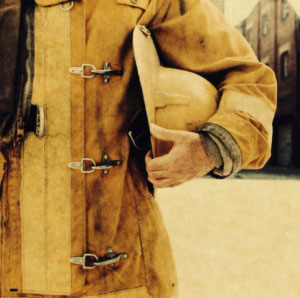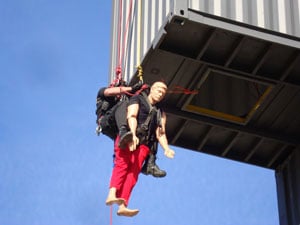 The United States Fire Administration (USFA) recently announced there were 81 on-duty firefighter fatalities in the United States as a result of incidents that occurred in 2011. This represents an almost seven percent decrease from the 87 fatalities reported for 2010. The 81 fatalities occurred in 33 states, one U.S. territory, and one overseas U.S.military facility. Texas experienced the highest number of fatalities (seven).
The United States Fire Administration (USFA) recently announced there were 81 on-duty firefighter fatalities in the United States as a result of incidents that occurred in 2011. This represents an almost seven percent decrease from the 87 fatalities reported for 2010. The 81 fatalities occurred in 33 states, one U.S. territory, and one overseas U.S.military facility. Texas experienced the highest number of fatalities (seven).
North Carolina experienced six firefighter deaths and was the only other state with five or more firefighter fatalities.Heart attacks were responsible for the deaths of 48 firefighters (59 percent) in 2011, nearly the same proportion of firefighter deaths from heart attack or stroke (60 percent) in 2010.
The United States Fire Administration (USFA) recently announced there were 81 on-duty firefighter fatalities in the United States as a result of incidents that occurred in 2011. This represents an almost seven percent decrease from the 87 fatalities reported for 2010. The 81 fatalities occurred in 33 states, one U.S. territory, and one overseas U.S. military facility. Texas experienced the highest number of fatalities (seven). North Carolina experienced six firefighter deaths and was the only other state with five or more firefighter fatalities.
“In 2004 at the initial Life Safety Summit, a number of fire service leaders did not believe we would complete a calendar year with less than 100 firefighter on-duty deaths,” U.S. Fire Administrator Ernest Mitchell said. “We broke through that perceived barrier in 2009, 2010, and now in 2011. We salute and congratulate our fire service family and pledge to continue working closely with the entire fire service community and its partners to maintain and even accelerate this downward trend in on-duty firefighter deaths.”Heart attacks were responsible for the deaths of 48 firefighters (59 percent) in 2011, nearly the same proportion of firefighter deaths from heart attack or stroke (60 percent) in 2010. Ten on-duty firefighters died in association with wildland fires, the lowest number of annual firefighter deaths associated with wildland fires since 1996. Fifty-four percent of all firefighter fatalities occurred while performing emergency duties. Three firefighters were killed in vehicle collisions.

 It is becoming more and more difficult to find a hilltop or a ridge in America that does not have some type of telecom tower placed on it. Likewise, there are many other types of towers popping up across the countryside and in our urban and suburban areas. Everything from wind turbine towers to high tension transmission line towers.
It is becoming more and more difficult to find a hilltop or a ridge in America that does not have some type of telecom tower placed on it. Likewise, there are many other types of towers popping up across the countryside and in our urban and suburban areas. Everything from wind turbine towers to high tension transmission line towers.

 and incident encountered. A second way is to use pre-built systems in an attempt to cover all situations. Both approaches have their advantages and disadvantages. Generally, build-as-you-go systems require marginally more initial training and may not have the same degree of skill retention as pre-built systems. But their advantage is the system can be tailored to fit the situation more readily and the components of the system can also be used for planned work activities. Pre-built systems have a slightly higher rate of skill retention and are ready to be employed as soon as they are put into service. They are, however, limited to a specific function and are not typically used for any other purpose other than for rescue. These pre-built systems are typically packaged in a protective pouch and can be fairly bulky. Thus, they’re typically left at ground level and must be retrieved before a rescue can commence.
and incident encountered. A second way is to use pre-built systems in an attempt to cover all situations. Both approaches have their advantages and disadvantages. Generally, build-as-you-go systems require marginally more initial training and may not have the same degree of skill retention as pre-built systems. But their advantage is the system can be tailored to fit the situation more readily and the components of the system can also be used for planned work activities. Pre-built systems have a slightly higher rate of skill retention and are ready to be employed as soon as they are put into service. They are, however, limited to a specific function and are not typically used for any other purpose other than for rescue. These pre-built systems are typically packaged in a protective pouch and can be fairly bulky. Thus, they’re typically left at ground level and must be retrieved before a rescue can commence. Whatever means you decide on to provide a tower rescue capability, as either a tower worker or as part of an emergency response team, it is absolutely imperative that you adhere to safe work practices while climbing by always using 100% fall protection. Seek out and attend professional tower rescue training; and, finally, ensure that the tower climbing/rescue equipment is in serviceable condition and is ready and available to be employed. For those of you in deer and elk country, be especially diligent to ensure that your pre-built system is where it’s supposed to be when hunting season comes around. Not only are they great for rescue, but they come in handy at the hunting camp also.
Whatever means you decide on to provide a tower rescue capability, as either a tower worker or as part of an emergency response team, it is absolutely imperative that you adhere to safe work practices while climbing by always using 100% fall protection. Seek out and attend professional tower rescue training; and, finally, ensure that the tower climbing/rescue equipment is in serviceable condition and is ready and available to be employed. For those of you in deer and elk country, be especially diligent to ensure that your pre-built system is where it’s supposed to be when hunting season comes around. Not only are they great for rescue, but they come in handy at the hunting camp also. In 1969, Fernand, with my brother Peter, started manufacturing a descender and a belay device designed by a caver named Bruno Dressler. This time was also a turning point in caving, as ropes replaced ladders as the sole means of vertical movement. This technique had already been developed by Jumar, for mountaineering, but cavers took the technique and adapted it for underground use. And this is how Petzl began…in my father’s 75 square meter workshop. My family – my father, mother, brother, wife, and I – designed the first tools for verticality and the first underground lamps, which lead, in 1972, to the Petzl headlamp.
In 1969, Fernand, with my brother Peter, started manufacturing a descender and a belay device designed by a caver named Bruno Dressler. This time was also a turning point in caving, as ropes replaced ladders as the sole means of vertical movement. This technique had already been developed by Jumar, for mountaineering, but cavers took the technique and adapted it for underground use. And this is how Petzl began…in my father’s 75 square meter workshop. My family – my father, mother, brother, wife, and I – designed the first tools for verticality and the first underground lamps, which lead, in 1972, to the Petzl headlamp. Roco Chief Instructor Randy Miller explains that trench collapse injuries and/or death is way too common in civil construction, and industrial maintenance projects. The sluggish economy entices organizations to cut corners, after all – time is money. This trend also extends to the homeowner and weekend warrior. Rather than hiring a certified/trained “trench” professional , do-it- yourself or do-it-with-the-resources on-hand seems the more practical. This breeds disaster.
Roco Chief Instructor Randy Miller explains that trench collapse injuries and/or death is way too common in civil construction, and industrial maintenance projects. The sluggish economy entices organizations to cut corners, after all – time is money. This trend also extends to the homeowner and weekend warrior. Rather than hiring a certified/trained “trench” professional , do-it- yourself or do-it-with-the-resources on-hand seems the more practical. This breeds disaster. 1. Personal accountability – Know where all your rescuers are at all times.
1. Personal accountability – Know where all your rescuers are at all times. UPDATE: OSHA recently unveiled its top 10 most frequently cited violations for 2010, and topping the list is Fall Protection. With 7,139 violations, Fall Protection is still at the top, switching places with last year’s first place holder, Scaffolding. OSHA reported that 260 workers died in 2010 from falls, which continues to be the leading cause of death in construction. So, you’ve developed an exemplary employee safety program and the shining gem is your fall protection program.
UPDATE: OSHA recently unveiled its top 10 most frequently cited violations for 2010, and topping the list is Fall Protection. With 7,139 violations, Fall Protection is still at the top, switching places with last year’s first place holder, Scaffolding. OSHA reported that 260 workers died in 2010 from falls, which continues to be the leading cause of death in construction. So, you’ve developed an exemplary employee safety program and the shining gem is your fall protection program. he irony is that an employer with an inadequate fall protection program may not face the need for a fallen/suspended worker rescue capability. In this environment, if the employee falls and has no PFAS, there is probably no need for rescue; it is more likely now a recovery. At this point, what the employee really needs is a “help wanted” ad to replace the employee and a very good lawyer.
he irony is that an employer with an inadequate fall protection program may not face the need for a fallen/suspended worker rescue capability. In this environment, if the employee falls and has no PFAS, there is probably no need for rescue; it is more likely now a recovery. At this point, what the employee really needs is a “help wanted” ad to replace the employee and a very good lawyer.


